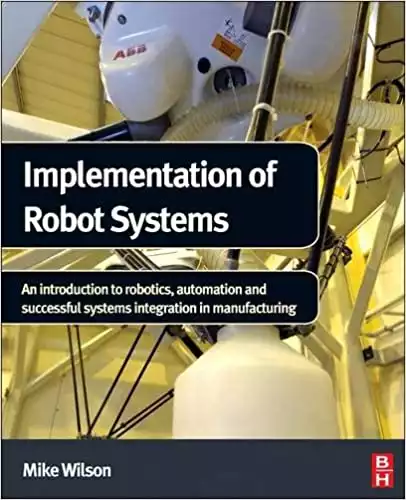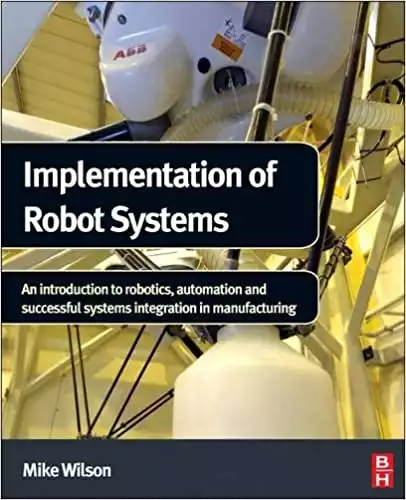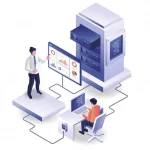What is Robots-as-a-Service (RaaS)?
RaaS is short for Robotics-as-a-Service, this is modeled around software-as-a-service model. where robots are leased / loaned along with the cloud platforms that support the robots. It helps organizations with lowering costs, saved time, continuous production cycle, better supply chain management, distribution management, and scaling opportunities to meet the growing needs of demand with a fraction of investment.
Table of contents
Understanding RaaS
Software-as-a-service (SaaS) or big data as a service (BDaaS) are both pay-per-use or subscription-based models of service delivery that have become increasingly popular in recent years. As opposed to buying robotic equipment outright, robots as a service lets customers lease robotic devices and access cloud-based subscriptions.Using RaaS, you avoid the headaches of owning expensive equipment and dealing with maintenance issues that arise.
It has become increasingly popular with businesses due to its flexibility, scalability, and lower entry cost as compared to traditional robotics programs, which makes RaaS a great alternative to traditional robotics programs. Due to these benefits, small- and medium-sized businesses are able to benefit from robotics without having to make the large investments that are often prohibitive at first.
A robot is generally used in companies to replace low-paying jobs that had previously been performed by humans within their organizations in order to cut costs and improve efficiency. It is however important to keep in mind that because robots are quite expensive, companies can have to wait for years before they can see a return on their investment. It is because of this reality that many smaller organizations have been unable to invest in robots. That is one of the reasons why RaaS is such an attractive concept today. As a result of RaaS, organizations can also scale up and down in response to changing market conditions and client needs very quickly and easily in order to keep up with the demands of the market.
Hardware has also become more affordable due to globalization, which has also lowered its cost. Additionally, it is easy to sign up for and find cheap and powerful cloud computing solutions that allow robots to be offered as a variable cost service with subscription packages that can be purchased in a variety of combinations. Most organizations have already experienced the benefits of using software as a service in their daily operations, so they already have a good understanding of the software as a service business model.
There are a number of companies in a number of different industries that are benefitting greatly from the use of RaaS, including warehouses, fulfillment centers, healthcare facilities, and security companies. In an era where other sectors are beginning to realize the potential of robots, the RaaS model makes it easier for them to test out and experiment with robotic solutions as other sectors realize the benefits.
Also Watch: 6 hours of robots!
RAAS – Organizations Providing Opportunities
With the advent of RaaS, small and medium businesses are now able to benefit from the advantages of robotic automation as well, since this technology is already having a significant impact on the automotive and manufacturing sectors.
Here are a few examples of companies developing tools for large-scale RaaS:
AWS RoboMaker is Amazon’s attempt to monitor analytics and provide a platform for RaaS.
Google is developing the new Google Cloud Robotics platform that combines AI, the cloud, and robotics to help create an “open ecosystem” of automated solutions that leverage cloud-based collaboration robots.
Microsoft is in the arena, too. RaaS for Windows is a platform which brings the power of Microsoft Windows 10 to the field of robotics, allowing developers to program robots in a way that is unparalleled by other programming languages, allowing them to create even more sophisticated robots and devices.
RaaS (Robotics as a Service) offered by Honda provides a variety of robots and cloud-based data services in order to facilitate collaboration between organizations.
Compared with having human security guards to guard premises, Cobalt Robotics offers robots to patrol buildings for 65 percent less money. The data collected and analyzed by the robots and artificial intelligence algorithms can provide insight into the security operations by giving the user insights into what is happening on the ground and distribution centers.
A company called Fetch Robotics offers on-demand automation for a wide range of payloads, facilities, and workflows. They were also named one of the technology pioneers by the World Economic Forum as having the potential to “shape the Fourth Industrial Revolution”. There are several advantages to using Fetch robots when it comes to automating warehouses, fulfillment centers operations in online retailers that have to deal with spikes in demand during the course of the year.A very appealing aspect of RaaS in these circumstances is how it enables companies to scale up on demand and meet the demands of a high demand quickly without the need to invest in equipment that will not be used during slower periods.
It is through its SmartFactory as a Service initiative that the Swiss-based industrial robotics company Kuka is offering its customers the option of renting out a complete automated plant that is staffed exclusively by robots, rather than just renting individual robots as is the case with most other business models.
Benefits of RAAS
There are many advantages to Robots-as-a-Service (RaaS), which includes greater flexibility and affordability when it comes to deploying automation and related services such as engineering, maintenance, and remote monitoring services.
In contrast to traditional ways of buying and implementing industrial automation, paying per item of work speeds up return on investment (ROI) and reduces total cost of ownership (TCO) for the deployment in comparison to traditional buying and implementing methods.
Today’s RaaS offerings typically include all the engineering and monitoring services, and the option to pay by the item of work that is performed. So, RaaS is more than just some type of pricing model.
RaaS can help organizations with smart fleet management software to help manage inventory and keep their warehouses lean. This will help reduce the carbon footprint, create smarter jobs like automation engineers, reduce manufacturing costs, and improve cost analysis.
This is possible when robotics suppliers leverage cloud robotics and subscription models to improve service and democratize costs. RaaS organizations can work on custom robot integration, demand for delivery robots, and work on a demand robot worker which can help in unique process improvements which will help with the reduction of waste on the production floor, aisle ways of production lines and improve the production cycle.
Lowers barriers
In the past, automating a facility with robotics was believed to be a luxury only afforded by the “big guys” due to the capital investment costs involved, says Rick Faulk, CEO of Locus Robotics, a leading developer of autonomous mobile robots (AMRs) for warehouse and logistics applications, according to Rick Faulk, CEO at Locus Robotics.
As a result of the RaaS model, you can dramatically reduce the operating costs and technological barriers associated with conventional automation solutions. They typically take years to be implemented. There are no hidden capital-intensive expenses or expensive maintenance contracts, and you’ll always have the latest software updates and hardware support built in.
RAAS for everyone
RaaS is able to achieve the goal of democratizing robotics automation because it lowers the cost of entry for users and brings cutting-edge robotics technology to warehouses of all sizes.
There is no reason to believe that RaaS is only for experts, despite its ability to reduce challenges. Labor and cost-control issues are universal to all firms, regardless of size. As a result of RaaS, operators of all sizes can control costs, realize a fast return on investment, respond to growing demand, as well as optimize their existing workforce. Adding services such as 24/7 remote monitoring, which reduces costs and downtimes, is also important for companies with larger capex.
There are some differences in the way automation is applied to hospitals and hospitality, where end users may not have the same level of familiarity with it as their industrial sector counterparts do. Fleets of its TUG service robots can be deployed at a time of 25-50 at a time, but small hotels that have a desire to deploy just one or two robots at a time are primarily driving the interest in pay-per-unit-of-work models.
Leasing options of RaaS give a competitive edge to the supply chains to ensure the adequate support, competitive advantage and financial incentive is in place to meet the ever shifting wide range landscape of demand.
Saves time
With the RaaS provider undertaking all the engineering and maintenance, companies can deploy automation even if they lack in-house expertise. In addition, fast deployments result in a significant return on investment.
With traditional automation, you went in and brought robots into your warehouse. Setting up robots, and automating processes would take about a year to 18 months to get up and running. With RaaS, you are able to see ROI within weeks, because all it takes is getting your people used to the robots within your facility and ramping them up to them. As soon as the system begins to meet productivity standards, you will start seeing ROI in a matter of weeks, as long as the system meets these standards.
RaaS enables operators to scale their bot fleets up and down seamlessly to meet spikes in demand and to respond to ever-changing market demands quickly, without having to hire additional, and often hard-to-find, employees. This is possible when robotic systems are supplied via a technology provider who can scale up to provide hundreds of robots in a short amount of time to help with the autoscaling impact of demand that can augment human coworkers.
Lowers cost in the long run
A significant advantage of the RaaS model is that operators of RaaS services are constantly updating and improving their technology, so customers do not need to worry about obsolescence. Customers are able to keep up with technology curve without worrying about where it is going and where they need to be.
This enables the businesses to focus on products and process improvements that help in reducing costs. Industrial robots, help any production unit to run 24/7 that helps organizations with adoption of robots. Industrial robots can be cage-free robots, collaborative robots, that can work alongside human coworkers to improve production cycle, and reduce costs. Aisleways of production lines can always be churning out product to meet the demands of consumers hence lowering the costs in a competitive market, and beat market trends to achieve market growth. With cloud technology, cloud-based systems that can help share data seamlessly to any distribution channel, to help with always-on supply chain, which in turn can help with the entire value chain to improve the costs in the longer run for the business.
The Future
As a result of exploding volumes and limited availability of labor, RaaS has been deemed to be the future of automation. However, operators are struggling to meet demand and control operational costs in an environment where exploding volumes are the norm. Because of RaaS’s ability to scale as needs change, operators can now take control of their business and deliver high levels of productivity and throughput today, as well as in the future, with the ability to gain control over their business as needs change. The biggest advantage of product lines being automated is reduction in maintenance costs that can be utilized in improving the value of the product via R&D. This means, better inventory management, better channel partners, shorter cycles of large scale deployments, automation of product lines via automation tools and better service providers, that ultimately leads to democratization of RaaS.
Investment community will be looking into improving the RaaS platforms to improve employee expertise of products across the board and collection of data to enable general artificial intelligence around products that these robots produce.
Also Read: Automated Farming
Challenges for RAAS
The amount of customization required for the robots to be useful for specific organizations still needs to be overcome. It is important to note that although a base platform might be the same across many entities, adaptations will need to be made for a robot to function, which will cause a longer implementation window as well as increased costs. RaaS will undoubtedly be the solution of choice for many organizations, regardless of the growing pains involved. Providing technical expertise, up skilling human workers, improving common base, with improved robotic tools and general collaborative robot, are critical pieces of the puzzle RaaS organizations need to get a better handle on to improve adoption of smarter robotics.
References
Alonso, Ignacio González, et al. Service Robotics within the Digital Home: Applications and Future Prospects. Springer Science & Business Media, 2011.
Marco, Ceccarelli. Service Robots and Robotics: Design and Application: Design and Application. IGI Global, 2012.
Zeghloul, Saïd, et al. Advances in Service and Industrial Robotics: Results of RAAD. Springer Nature, 2020.












